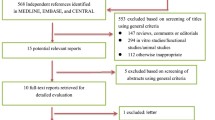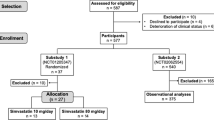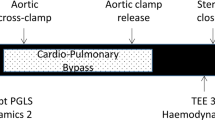Abstract
Summary. We aimed to assess the clinical efficacy of glucose-insulin-potassium (GIK) in acute myocardial infarction. Experimental data provided evidence of the beneficial effects of GIK on ischemic myocardium. The clinical trials, mostly uncontroled and conducted mainly before the thrombolytic era, were inconclusive due to the small number of patients and discrepancies in protocols. In order to evaluate the efficacy of this intervention, we have performed a prospective multicenter randomized study. The study consisted of 954 patients with acute myocardial infarction (MI) randomized within 24 hours from the onset of symptoms to low-dose GIK (n = 494), which consisted of 1000 mL 10% dextrose, 32–20 U insulin, and 80 mEq K+, or to the control group (n = 460), which was given 1000 mL 0.09% sodium chloride, by intravenous 24-hour infusion at a rate of 42 mL/h. Cardiac mortality and the occurrence of cardiac events at 35 days did not differ between GIK and control-allocated patients (32 (6.5%) vs. 21 (4.6%), respectively; OR 1.45, 95% CI 0.79–2.68, P = 0.20; and 214 (43.3%) vs. 192 (41.7%), OR 1.07, 95% CI 0.82–1.38, P = 0.62). Total mortality at 35 days was significantly higher in the GIK than in the control group (44 (8.9%) vs. 22 (4.8%), respectively, OR 1.95, 95% CI 1.12–3.47, P = 0.01). The excess of noncardiac deaths in the GIK group may have occurred by chance. Low-dose GIK treatment does not improve the survival and clinical course in acute MI.
Similar content being viewed by others
References
Staszewska-Barczak J, Ceremużyński L. The continuous estimation of catecholamine release in the early stages of myocardial infarction in the dog. Clin Sci 1968;34:531–539.
Ceremużyński L. Hormonal and metabolic reactions evoked by acute myocardial infarction. Circ Res 1981;48:767–776.
Allison SP, Chamberlain MJ, Hinton P. Intravenous glucose tolerance, insulin, glucose and free fatty acid levels after myocardial infarction. Br Med J 1969;2:776–778.
Ceremużyński L, Kuch J, Markiewicz L, Ławecki J, Tatoń J. Patterns of endocrine reactivity in patients with recent myocardial infarction. Clinical and biochemical correlations: Trial of endocrine therapy. Br Heart J 1970;32:603–610.
Kurien VA, Oliver MF. Serum free fatty acids after acute myocardial infarction and cerebral vascular occlusion. Lancet 1966;2:122–127.
Januszewicz W, Sznajderman M, Wocial B, Prejbisz J. Urinary excretion of free norepinephrine and epinephrine in patients with acute myocardial infarction in relation to its clinical course. Am Heart J 1968;76:345–352.
Oliver MF, Kurien VA, Greenwood TW. Relation between serum free fatty acids and arrhythmias and death after acute myocardial infarction. Lancet 1968;1:710–715.
Oliver MF, Opie LH. Effects of glucose and fatty acids on myocardial ischaemia and arrhythmias. Lancet 1994;343:155–158.
Sodi-Pallares D, Testelli MR, Fishleder BL, Bisteni A, Medrano GA, De Micheli A. Effects of an intravenous infusion of a potassium-glucose-insulin solution on the electrocardiographic signs of myocardial infarction. Am J Cardiol 1962;9:166–181.
Dalby AJ, Bricknell OL, Opie LH. Effect of glucose-insulin-potassium infusions on epicardial ECG changes and on myocardial metabolic changes after coronary artery ligation in dogs. Cardiovasc Res 1981;15:588–598.
Maroko PR, Libby P, Sobel BE et al. Effect of glucose-insulin-potassium infusion on myocardial infarction following experimental coronary artery occlusion. Circulation 1972;45:1160–1175.
Apstein CS, Gravino FN, Haudenschild CC. Determinants of a protective effect of glucose and insulin on the ischaemic myocardium. Circ Res 1983;52:515–526.
Cunningham MJ, Apstein CS, Weinberg EO, Vogel WM, Lorell BH. Influence of glucose and insulin on the exaggerated diastolic and systolic dysfunction of hypertrophied rat hearts during hypoxia. Circ Res 1990;66:406–415.
Ahmed SS, Lee CH, Oldewurtel HA, Regan TJ. Sustained effect of glucose-insulin-potassium on myocardial performance during regional ischaemia. J Clin Invest 1977;61:1123–1135.
Obeid AI, Verrier RL, Lown B. Influence of glucose, insulin and potassium on vulnerability to ventricular fibrillation in the canine heart. Circ Res 1978;43:601–608.
Russel DC, Oliver MF. The effect of intravenous glucose on ventricular vulnerability following acute coronary artery occlusion in the dog. J Moll Cell Cardiol 1979;11:31–44.
Opie LH, Owen P. Effect of glucose-insulin-potassium infusions on arteriovenous differences of glucose and of free fatty acids and on tissue metabolic changes in dogs with developing myocardial infarction. Am J Cardiol 1976;38:310–321.
Opie LH, Bruyneel K, Owen P. Effects of glucose, insulin and potassium infusion on tissue metabolic changes within the first hour of myocardial infarction in the baboon. Circulation 1975;52:40–49.
Coleman GM, Gradinac S, Taegtmeyer H, Sweeney M, Frazier OH. Efficacy of metabolic support with glucose-insulin-potassium for left ventricular pump failure after aortocoronary bypass surgery. Circulation 1989;80:I91–I96.
Opie LH. Metabolism of free fatty acids, glucose and catecholamines in acute myocardial infarction. Am J Cardiol 1975;36:938–953.
Opie LH. Hypothesis: Glycolytic rates control cell viability in ischaemia. J Appl Cardiol 1988;3:407–414.
Rogers WJ, Stanley AW, Breinig JB, et al. Reduction of hospital mortality rate of acute myocardial infarction with glucose-insulin-potassium infusion. Am Heart J 1976;92:441–454.
Rogers WJ, Segall PH, McDaniel HG, Mantle JA, Russel RO, Rackley CE. Prospective randomized trial of glucose-insulin-potassium in acute myocardial infarction. Am J Cardiol 1979;43:801–809.
Heng MK, Norris RM, Singh BN, Barratt-Boyes C. Effects of glucose and glucose-insulin-potassium on haemodynamics and enzyme release after acute myocardial infarction. Br Heart J 1977;39:748–757.
Whitlow PL, Rogers WJ, Smith LR, et al. Enhancement of left ventricular function by glucose-insulin-potassium infusion in acute myocardial infarction. Am J Cardiol 1982;49:811–820.
Sundstedt C-D, Sylven C, Mogensen L. Glucose-insulin-potassium-albumin infusion in the early phase of acute myocardial infarction — a controlled study. Acta Med Scand 1981;210:67–71.
Mittra B. Potassium, glucose and insulin in treatment of myocardial infarction. Lancet 1965;2:607–609.
Medical Research Council Working Party on the Treatment of Myocardial Infarction. Potassium, glucose and insulin treatment of acute myocardial infarction. Lancet 1968;2:1355–1360.
Pentecost BL, Mayne NMC, Lamb P. Controlled trial of intravenous glucose, potassium and insulin in acute myocardial infarction. Lancet 1968;1:946–948.
Breslow NE, Day NE. The analysis of case-control studies. Lyon, France: IARC Scientific Publications, no. 32, 1980.
Mantel N, Haenszel W. Statistical aspects of the analysis of data from retrospective studies of disease. J Natl Cancer Inst 1959;22:719–748.
EaSt Manual: Application to Normal and Binomial Data. Cambridge, MA: Cytel Software Corporation, 1993.
Ceremużyński L, Kraska T, Słucka C. Preliminary clinical experience with the application of the polarizing mixture (potassium, insulin, glucose) in myocardial infarction, [in Polish]. Pol Arch Med Wewn 1964;34:541–547.
Ceremużyński L, Herbaczyńska-Cedro K, Woźniewicz B. Effectiveness of insulin-glucose in preventing adrenaline-induced myocardial and systemic disturbances in the dog. Jpn Circ J 1980;44:740–748.
Haneda T, Ganz W, Burnam MH, Katz J. Metabolic effects of glucose-insulin-potassium in the ischaemic myocardium. Jpn Heart J 1978;19:376–382.
Heng MK, Norris RM, Peter T, Nisbet HD, Singh BN. The effect of glucose-insulin-potassium on experimental myocardial infarction in the dog. Cardiovasc Res 1978;12:429–435.
Kostis JB, George J, Hayase K, Moreyra AE, Kuo PT. Effect of glucose-insulin-potassium solution on the exercise performance of patients with coronary artery disease. Am Heart J 1979;98:351–360.
Thadani U, Chiong MA, Parker JO. Effects of low and high glucose in a glucose-insulin-potassium infusion on haemodynamics and exercise tolerance in patients with angina pectoris. Circulation 1980;61:266–276.
Stanley AW, Moraski RE, Russell RO, et al. Effects of glucose-insulin-potassium on myocardial substrate availability and utilization in stable coronary artery disease. Am J Cardiol 1975;36:929–937.
Zaleska T, Dłużniewski M, Ceremużyński L. Effect of polarizing mixture (potassium, insulin, glucose) on the concentration of free fatty acids in acute myocardial infarction [in Polish]. Pol Arch Med Wewn 1977;58:149–154.
Malmberg K, Ryden L, Hamsten A, Herlitz J, Waldenstrom A, Wedel H. Effects of insulin treatment on one-year mortality and morbidity in diabetic patients with acute myocardial infarction: DIGAMI study group: Diabetes Insulin-Glucose in Acute Myocardial Infarction. Eur Heart J 1996;17:1337–1344.
Arsenian MA, New PS, Cafasso CM. Safety, tolerability, and efficacy of a Glucose-Insulin-Potassium-Magnesium-Carnitine solution in acute myocardial infarction. Am J Cardiol 1996;78:476–479.
Fath-Ordoubadi F, Beatt KJ. Glucose-Insulin-Potassium therapy for treatment of acute myocardial infarction. An overview of randomized placebo-controlled trials. Circulation 1997;96:1152–1156.
Diaz R, Paolasso EA, Piegas LS, Tajer CD, et al. on behalf of the ECLA (Estudios Cardiologicos Latinoamerica) Collaborative Group. Metabolic modulation of acute myocardial infarction. The ECLA glucose-insulin-potassium Pilot Trial. Circulation 1998;98:2227–2234.
Author information
Authors and Affiliations
Rights and permissions
About this article
Cite this article
Ceremużyński, L., Budaj, A., Czepiel, A. et al. Low-Dose Glucose-Insulin-Potassium Is Ineffective in Acute Myocardial Infarction: Results of a Randomized Multicenter Pol-GIK Trial. Cardiovasc Drugs Ther 13, 191–200 (1999). https://doi.org/10.1023/A:1007787924085
Issue Date:
DOI: https://doi.org/10.1023/A:1007787924085




